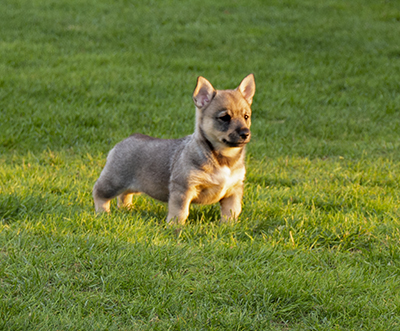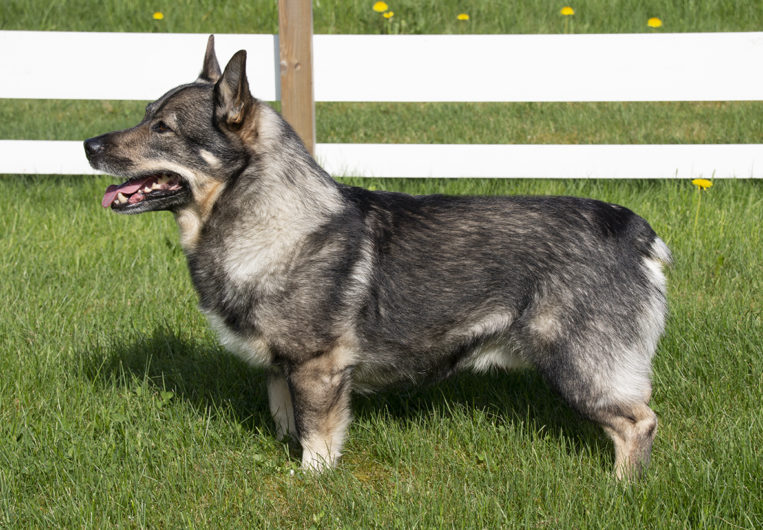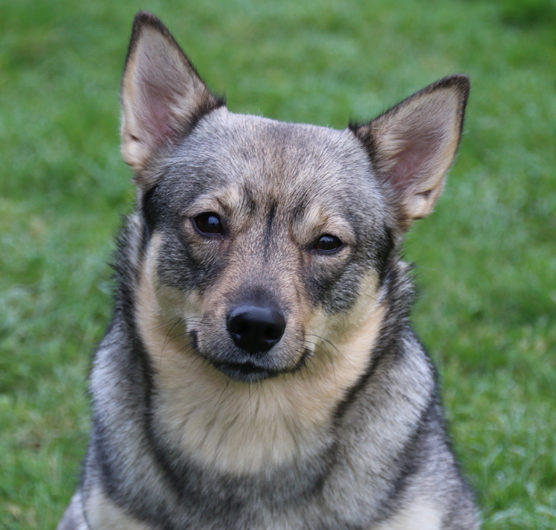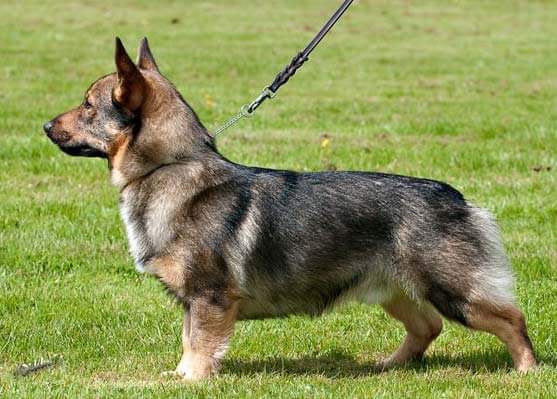About the Swedish Vallhund - Västgötaspets
Text: Peta Dowle
GENERAL APPEARANCE
- A small powerful, fearless, short-legged dog. Appearance and expression denote a watchful, alert and energetic dog.
IMPORTANT PROPORTIONS
- The relation between height and length of the body is about 2 : 3.
HEAD
- Head rather long and clean cut. When viewed from above, forms an even wedge from skull to the tip of the nose.
CRANIAL REGION
- Skull: Almost flat.
- Stop: Well defined.
FACIAL REGION
- Nose : Pigmentation jet black.
- Muzzle: When viewed from the side, looks rather square. The muzzle is slightly shorter than the skull.
- Lips: Tightly closed.
- Jaws/ Teeth: Perfect and regular scissor bite with even and well-developed teeth.
- Eyes: Medium size, oval in shape and dark brown.
- Ears: Medium size, pointed, pricked and ear leather is hard from base to tip, smooth-haired and mobile. Set on not too low.
NECK
- Long and strongly muscled with good reach.
BODY
- Topline: Back level, well muscled.
- Loin: Short, strong.
- Croup: Broad and slightly sloping.
- Chest: Long with good depth. Well sprung ribs. When viewed from the front, the chest is oval, from side, elliptical. It reaches two-fifths of the length of the forelegs and, when viewed from the side, the lowest point of the chest is immediately behind the back part of the foreleg.
- Underline: Belly slightly tucked up.
BEHAVIOUR/ TEMPERAMENT
- The breed is watchful, energetic, fearless, alert, intelligent, active, eager and very loyal. A Swedish Vallhund is a thinking dog who is happiest being with his ‘people’. He likes a job or interesting things to do. This is why dog sports such as agility and obedience are so good for them. They make excellent trackers for they have a very good nose and the drive to stick to task. They thrive working stock or playing all day with children.
THE NEGATIVES
The breed does not do well as an only dog home alone all day while his people work.
An understimulated and bored Swedish Vallhund will quickly become a boredom barker. Individual Swedish Vallhunds will be prone to barking also, this is stoppable with correction and providing an interesting and stimulating life.
The other significant thing to watch for is heel nipping. As their natural herding trait is bred into them, some puppies will find the running legs of little children irresistible to chase and will nip and tug at trouser legs. This is easily corrected but must be stopped. Not all puppies will react this way, but if they do you must correct a puppy. Growl at them and let them know instantly that this is a no-no. Inhibit this behaviour early if you see it so that it never becomes a problem. As they are very intelligent and easily trained it is not a difficult problem to solve.
GETTING THE DECISION RIGHT
Do your research. If you have never met a Swedish Vallhund and have been attracted by the description or a photograph, make sure you get to meet an adult Swedish Vallhund before you commit to getting a puppy.
As the typical lifespan of a Swedish Vallhund is between 13 – 16 years it is worth taking the time early on to do your homework.
Socialisation is important as a puppy. The more your puppy has done and met in terms of new experiences, the better they will be as adult family pets. Ensure that before they are 16 weeks that they have been for a few car rides, met cats, the postee and other aspects of your regular life. Ask the breeder what they will be doing to socialise the puppy for the first 8 weeks of life. Sign up for puppy kindy classes, and basic obedience training. A well-trained dog is a happy dog.
If you are going to go ahead with getting a puppy, we hope you fall in love with the breed. They are a special, rare and exciting little dog, full of character and courage. Perhaps if you decide also to join the Swedish Vallhund Club we will get to meet you at one of our gatherings.
TAIL
- Two types of tails occur, long or natural short tail. In both cases all variations are acceptable.
- Are Some Tail Docked? The other most visually noticeable aspect of the breed is that some have a tail, or stub of a tail and others have no tail at all. It is a quirk of the breed that 51% of them are born without tails. This genetic quirk is a special aspect that has been kept and preserved by breeders. The same genes that creates the no-tail example of Swedish Vallhund also creates the stub-tails (a little stump of a tail). In fact, occasionally a dog will be born with half a tail. This is quite acceptable. Tails come in a variety. As they are a Spitz breed, typically the tail is carried up over the back in a tight curl. But also as a loose curl or sickle. Some tails are bushy others less so. All are expected and acceptable normal variations. Sometimes people prefer the tail or fixate specifically on having a tailed dog. More importantly, it is good to understand that there is so much more to a Swedish Vallhund than whether or not he has a tail
LIMBS
- Forequarters: Forelegs well boned.
- Shoulder: Shoulder-blade long and well laid back.
- Upper arm: Slightly shorter than the shoulders and set at a distinct angle. Upper arm lies close to ribs but is still very mobile.
- Forearm: When viewed from the front, slightly bent, just enough to give them free action against the lower part of the chest.
- Pastern: Elastic.
- Legs: Well boned.
- Hindquarters: Hindlegs well angulated at stifle and hock. Seen from behind, they are parallel.
- Thighs: Strongly muscled.
- Lower thigh: Slightly longer than the distance from hock to ground.
- Feet: Medium sized, short, oval, pointing straight forward with strong pads and well knuckled up.
GAIT / MOVEMENT
- Sound with a good drive.
COAT
- Hair: Medium length, harsh, close and tight topcoat; undercoat soft and dense. The coat is short on foreparts of the legs, slightly longer on neck, chest and backparts of the hindlegs.
- Colour: Desirable colours are grey, greyish brown, greyish yellow or reddish brown with darker hairs on back, neck and sides of the body. Lighter hair in the same shade of colour as mentioned above can be seen on muzzle, throat, chest, belly, buttocks, feet and hocks. Lighter markings on shoulders, so called harness markings, desirable. White is permitted to a small extent as a narrow blaze, neckstop or slight necklace. White markings are permitted on fore-and hindlegs and on the chest.
- They have an easy-care coat. Short and hard and not dissimilar in feel to that of a Labrador Retriever. Swedish Vallhunds though have a coat made up of a ‘double layer’. There are a softer woolly undercoat and a slightly longer overlayer of guard hairs. Colours vary from several shades of grey through to red. Most Swedish Vallhunds carry no white or minimal white. Others have a handsome white chest (shirt front) or white facial blaze. The breed standard allows for a ‘light necklace’ of white. More than a third of a Swedish Vallhund being white is considered a breed fault. These examples should not be breed from and can not be shown. However, it is important to understand that this amount of white is simply a natural variation of coat colouring and dogs with significant areas of white coat make very acceptable pets. Swedish Vallhunds only need a brush once a week to remove loose hairs. And daily brushing through their 3 – 4 week moult adjusting to their summer coat. Particularly attractive is their wolf type facial markings and shoulder harness. Swedish Vallhunds have low doggy-odour. That isn’t no-odour, but their significant lack of dog smell is something often commented on. They do not need regular bathing as they are self-care, dry dirt will fall from coats and the natural oils in their coat serve them well.
SIZE AND WEIGHT
- Height at withers: Dogs 33 cm. Bitches 31 cm. A variation of 1.5 cm above or below these heights is permitted.
- Weight: Between 9 – 14 kg.
FAULTS
- Any departure from the foregoing points should be considered a fault and the seriousness with which the fault should be regarded should be in exact proportion to its degree.
- Any dog clearly showing physical or behavioural abnormalities shall be disqualified.
- N.B. : Male animals should have two apparently normal testicles fully descended into the scrotum.





